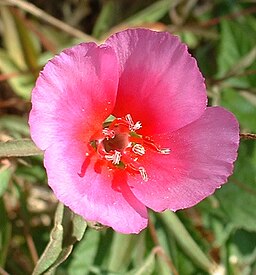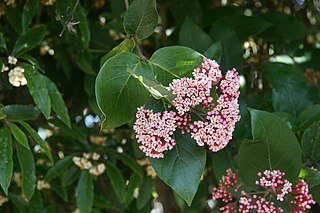
The lazuli bunting is a North American songbird named for the gemstone lapis lazuli.

Clarkia is a genus within the flowering plant family Onagraceae. Over 40 species are currently classified in Clarkia; almost all are native to western North America, though one species is native to South America.

Clarkia amoena is a flowering plant native to western North America, found in coastal hills and mountains from British Columbia south to the San Francisco Bay Area.
Griphobilharzia amoena is a significant trematode that infect crocodiles such as the Australian freshwater crocodile, Crocodylus johnstoni, located in Darwin, Australia with reported illness in Irian Jaya as well. They possess a distinctive tegument that is composed of two lipid bilayers instead of a single bilayer. The double bilayer may be an adaptation to survive the host’s immune response.

Rogiera amoena is a shrub or small tree in the Rubiaceae family, sometimes grown as an ornamental plant. Common names include rondeletia and yellowthroat rondeletia. The species is native to Mexico, Belize, Guatemala, El Salvador, Nicaragua, Costa Rica and Panama.
Colobotheini is a tribe of longhorn beetles of the Lamiinae subfamily.

Colobothea is a genus of longhorn beetles of the subfamily Lamiinae.

Rubramoena amoena is a species of sea slug, an aeolid nudibranch, a marine gastropod mollusc in the family Fionidae.
Colobothea biguttata is a species of beetle in the family Cerambycidae. It was described by Bates in 1865. It is known from Brazil and Ecuador.
Colobothea bisignata is a species of beetle in the family Cerambycidae. It was described by Bates in 1865. It is known from Surinam, French Guiana, Guyana, Peru, Brazil, Ecuador.
Colobothea naevia is a species of beetle in the family Cerambycidae. It was described by Bates in 1865. It is known from Brazil and Ecuador.
Colobothea pictilis is a species of beetle in the family Cerambycidae. It was described by Bates in 1865. It is known from Brazil and French Guiana.
Colobothea pura is a species of beetle in the family Cerambycidae. It was described by Bates in 1865. It is known from Brazil.
Colobothea elongata is a species of beetle in the family Cerambycidae. It was described by Gahan in 1889. It is known from French Guiana and Brazil.
Colobothea plagiata is a species of beetle in the family Cerambycidae. It was described by Per Olof Christopher Aurivillius in 1902 and is known from Colombia.
Colobothea peruviana is a species of beetle in the family Cerambycidae. It was described by Per Olof Christopher Aurivillius in 1920 and is known from Peru.
Colobothea femorosa is a species of beetle in the family Cerambycidae. It was described by Erichson in 1847. It is known from Peru.
Colobothea fibrosa is a species of beetle in the family Cerambycidae. It was described by Erichson in 1847. It is known from Peru.
Colobothea varia is a species of beetle in the family Cerambycidae. It was described by Johan Christian Fabricius in 1787. It is known from Venezuela, Panama, and French Guiana.

Felicia amoena is a variably hairy, sometimes glandular, biennial or perennial plant, of about 25 cm (10 in) high, that is assigned to the daisy family. It is somewhat woody at its base, roots at the nodes if these contact the soil, and has ascending branches. The leaves are oppositely arranged along the stems at and just above a branching fork, further up. The flower heads sit individually on up to 12 cm long stalks. They are 2–3 cm in diameter and consist of about twelve to twenty five heavenly blue ray florets that surround many yellow disc florets. Three subspecies have been recognised, that differ in width of the leaves and the involucral bracts, the size of the heads and number of ray florets and in having glandular hairs. These can be found in coastal sands and inland areas in the Western Cape and Eastern Cape provinces of South Africa. Flower heads can be found from June till October.







